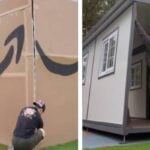We adhere to strict standards of editorial integrity to help you make decisions with confidence. Some or all links contained within this article are paid links.
Imagine buying a home for less than a Honda Civic, ordering the house to your location, and unpacking your new home on top of your property.
A two-bedroom prefabricated home recently sold out on Amazon. The house, which was listed at $19,000, featured a toilet and shower, a living room and a kitchen.
The mostly metal home folds out from its package to reveal a fully assembled single-story structure, complete with a porch, staircase and gable roof overhang. The manufacturer claims the house is built to last 15 years.
It’s unclear exactly how many people have bought tiny homes on Amazon, but it is estimated that there are over 10,000 tiny homes in the U.S., including billionaire Elon Musk’s recently-launched tiny modular homes, starting at $10,000.
While these viral tiny homes on Amazon may seem like a quick and affordable way to get on the property ladder, there’s a catch — issues like poor reviews, lack of instructions, and limited space can make them more hassle than they’re worth.
If you’re looking to get on the property ladder, there may be better, hassle-free investments for your hard-earned cash.
Influencers unbox housing stock
Following the trend of social media personalities, Nathan Graham and Jeffrey Bryant have posted viral videos on YouTube and TikTok, unboxing tiny homes purchased from Amazon.
Graham’s five-part TikTok series, with over 20 million views, shows him and his friends unpacking a $17,000 Chery Industrial Expandable Prefab House. Despite no assembly instructions or reviews, Graham found the home easy to set up.
On the other hand, Bryant’s video, with over 9 million views, reveals mixed feelings about his $26,000 tiny home, highlighting both its quality and limitations.
The doors and bathroom appear OK, but Bryant notes he can touch the ceiling without fully extending his arm despite being five-foot-eight. “I don’t even know where I’m going to put the house,” a remorseful-sounding Bryant said.
Downsides of downsizing
Bryant’s issue shows how the valuations of tiny homes can be misleading.
Buying a traditional house comes with the property it’s already sitting on. Not so for a tiny home.
Connecting your home to the local electricity grid can cost up to $1,500 if you’re near a utility pole, and up to $5,000 if you’re on a rural property.
Then there’s the plumbing.
Some municipalities charge $3,000 for a water meter while sewer lines cost up to $180 per foot. Tiny home occupants hoping to live off the grid can install solar panels and a septic tank, which come with their own costs.
Hassle-free property ownership
Getting on the property ladder doesn’t have to mean downsizing, or settling for a home that looks like a box. Whether you have $20,000, $50,000, or $100,000 to invest, there are innovative ways to enter the real estate market without sacrificing quality or taking on excessive risk.
The $36 trillion U.S. home equity market has historically been the exclusive playground of large institutions.
Homeshares is changing the game by allowing accredited investors to gain direct exposure to hundreds of owner-occupied homes in top U.S. cities through their U.S. Home Equity Fund — without the headaches of buying, owning, or managing property.
The fund focuses on homes with substantial equity, utilizing Home Equity Agreements (HEAs) to help homeowners access liquidity without incurring debt or additional interest payments. This approach provides an effective, hands-off way to invest in high-quality residential properties, plus the added benefit of diversification across various regional markets – with a minimum investment of $25,000.
With risk-adjusted internal returns ranging from 12% to 18%, the U.S. Home Equity Fund could unlock lucrative real estate opportunities, offering retail investors a low-maintenance alternative to traditional property ownership.
Another avenue for real estate investing is commercial real estate.
First National Realty Partners allows individual investors to access grocery-anchored commercial real estate investments with a minimum of $50,000.
With FNRP, investors own a share of properties leased by national brands like Whole Foods, Kroger and Walmart, providing a stable, positive cash flow without the worry of tenant costs and management.
Accredited investors can use their secure platform to explore available deals, engage with experts, and access the potential for quarterly returns.
If you’re looking for an option with a lower minimum investment requirement, platforms like Arrived could be an option.
Backed by world-class investors like Jeff Bezos, Arrived allows investors to buy stakes in rental homes and vacation rentals without having to worry about tenant management.
You can pick from a curated selection of homes and invest in your own share. Best of all, you can start investing in rental properties with just $100.
This article provides information only and should not be construed as advice. It is provided without warranty of any kind.
